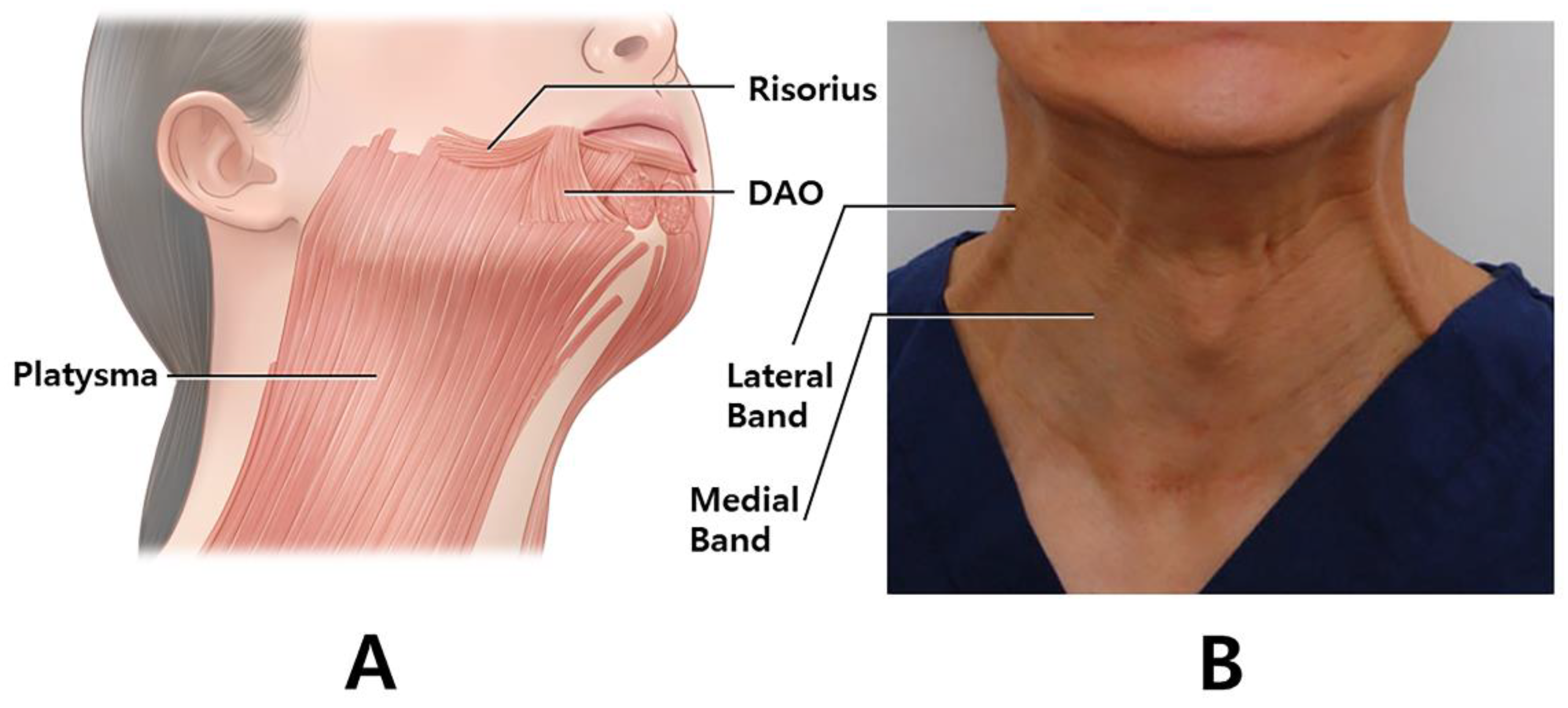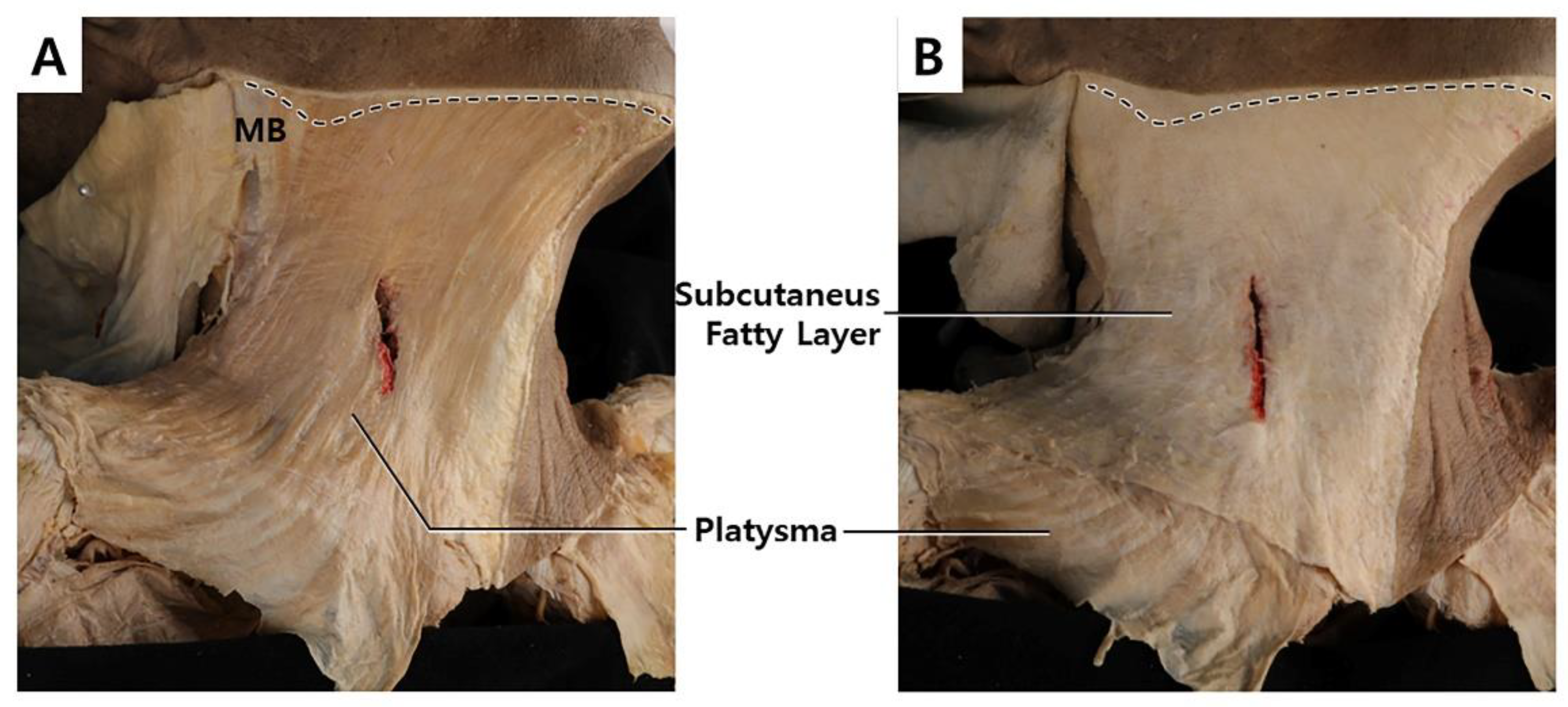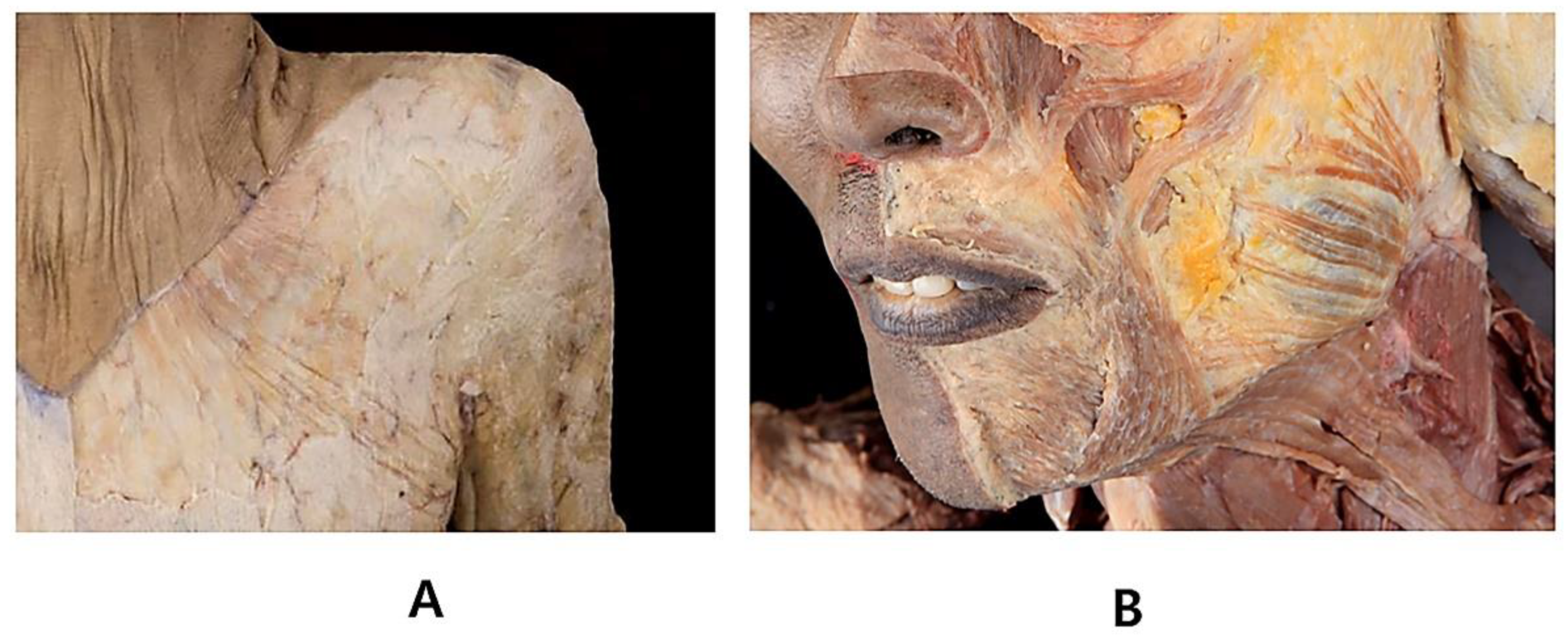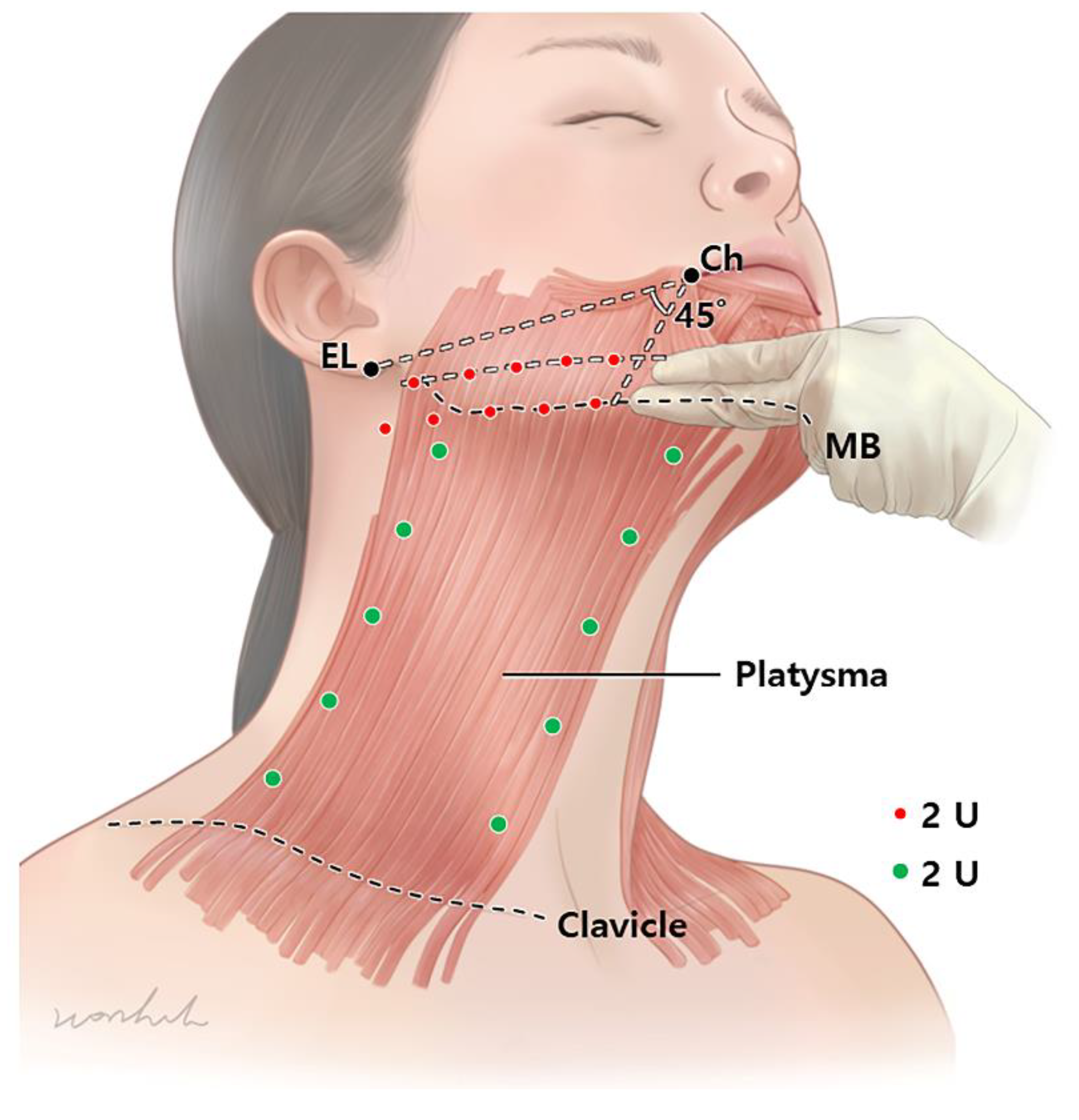Your browser does not fully support modern features. Please upgrade for a smoother experience.

Submitted Successfully!
Thank you for your contribution! You can also upload a video entry or images related to this topic.
For video creation, please contact our Academic Video Service.
Video Upload Options
We provide professional Academic Video Service to translate complex research into visually appealing presentations. Would you like to try it?
Cite
If you have any further questions, please contact Encyclopedia Editorial Office.
Yi, K.; Lee, J.; Lee, K.; Hu, H.; Lee, H.; Kim, H. Botulinum Neurotoxin Injection Targeting the Platysma Muscle. Encyclopedia. Available online: https://encyclopedia.pub/entry/38967 (accessed on 15 January 2026).
Yi K, Lee J, Lee K, Hu H, Lee H, Kim H. Botulinum Neurotoxin Injection Targeting the Platysma Muscle. Encyclopedia. Available at: https://encyclopedia.pub/entry/38967. Accessed January 15, 2026.
Yi, Kyu-Ho, Ji-Hyun Lee, Kangwoo Lee, Hye-Won Hu, Hyung-Jin Lee, Hee-Jin Kim. "Botulinum Neurotoxin Injection Targeting the Platysma Muscle" Encyclopedia, https://encyclopedia.pub/entry/38967 (accessed January 15, 2026).
Yi, K., Lee, J., Lee, K., Hu, H., Lee, H., & Kim, H. (2022, December 19). Botulinum Neurotoxin Injection Targeting the Platysma Muscle. In Encyclopedia. https://encyclopedia.pub/entry/38967
Yi, Kyu-Ho, et al. "Botulinum Neurotoxin Injection Targeting the Platysma Muscle." Encyclopedia. Web. 19 December, 2022.
Copy Citation
The platysma muscle is a thin superficial muscle that covers the entire neck and lower part of the face. The platysma muscle is the primary target muscle for botulinum neurotoxin injection therapy aimed at treating platysmal band and lower facial lifting. In the procedure of botulinum neurotoxin injection therapy, a lack of knowledge of the anatomy of the platysma muscle and the properties of botulinum neurotoxin can lead to side effects such as dysphagia, dysphonia, and weakness of the neck muscles. Anatomically safe injection sites have been proposed for the platysma muscle, and the appropriate injection technique has been reviewed.
botulinum neurotoxin
platysma band
platysma muscle
dermotoxin
injection point
face lifting
1. Introduction
Clostridium botulinum produces botulinum neurotoxin (BoNT), which prevents the release of acetylcholine at the motor end plate [1][2]. In aesthetic settings, BoNT is frequently used to target the platysma muscle to diminish the platysmal band or jawline lifting (Figure 1A). Platysma bands are two strips of muscle bands that are found in the hypercontraction status of the platysma muscle (Figure 1B). The bands get more prominent with age and become an aesthetic concern [3].

Figure 1. The image of the playsmal bands. The posterior and anterior platysmal bands are targeted for botulinum neurotoxin (A). Schematic image of the platysma muscle in oblique view. The muscle intermingles with the depressor anguli oris, depressor labii inferioris, mentalis, risorius, and orbicularis oris muscles (B). (DAO; depressor anguli oris).
awline lifting is also an aesthetic treatment conducted with BoNT injection in the jawline, which is given in the platysma muscle [4].
The platysma muscle acts by pulling down the modiolus, corners of the mouth, and lower third of the face. Therefore, BoNT injection into the platysma muscle results in lifting of the lower third of the face and jawline contour, which improves the esthetic appearance by correcting the drooping corners of the mouth and jowls.
However, an overdose of BoNT may paralyze nearby muscles, causing dysphonia, dysphagia, and an asymmetrical appearance [5]. Inadvertent diffusion of BoNT into the depressor labii inferioris or risorius muscle may result in an asymmetric smile (Figure 1B). To prevent these undesirable results, anatomy-based precise injection in the platysma muscle and beginning the primary treatment on a lower quantity of BoNT are recommended. Recent studies on BoNT injection in specific locations for anatomical assessments of particular muscles have been conducted on the basis of external anatomical features [6][7].
Clinicians treating the platysma muscle need to have a good understanding of the anatomy of the jaw and neck. However, few anatomical findings have been reviewed with clinical application (location, injection technique, and dosage).
2. Anatomy of the Platysma Muscle
The platysma is a superficially located thin and broad muscle underneath the subcutaneous fatty layer, which covers most of the neck region (Figure 2A) [8]. The superior part of the platysma muscle, involved in expression, pulls the cheilion inferiorly and widens the lips. The inferior part of the platysma muscle acts by pulling the skin of the neck superiorly. Neural innervation is facilitated by the cervical branch of the facial nerve, and blood supply is facilitated by branches of the submental and suprascapular arteries. The platysma muscle originates from the fascial structure of the pectoralis major and ends at the anterior deltoid (Figure 3A). The muscle fibers superiorly blend medially into the depressor anguli oris, depressor labii inferioris, and lower lip, and laterally form the superficial musculoaponeurotic system (Figure 3B).

Figure 2. The dissected image of the platysma muscle in a cadaver (A) and revealing platysma muscle by removing subcutaneous tissue (B).

Figure 3. Platysma muscle continuously extends to the fascial structure of pectoralis major and anterior deltoid (A). The platysma also extends to mid-face region (B).
In the middle of the neck, the platysma is absent in the lower region and partially exists in the upper region depending on the individual. The upper region of the middle neck has some partly decussated fibers, covering the submental region. A previous study revealed that 85% of medial platysmal fibers decussate in the submental region. In 43% of subjects, the decussating fibers extended more than 20 mm below the mandibular border. It was suggested that gobbler neck deformity can be present in individuals with no decussation or less decussation, along with sagging of nearby subcutaneous tissue. In an aesthetic setting, an anatomical structure called the superficial cervical fascia (investing layer) often refers to the subdermal layer (Figure 2B). The structure includes adipose tissue, lymph nodes, nerves, and vessels that are superficially located, including the platysma muscle.
3. Platysmal Band Injection Points and Methods
Two units (U) are injected per point, and five points are injected for each band, approximately 2 cm from each other along the muscular band. A total of 40 units are used on both sides of the medial and lateral bands. The type of the botulinum toxin proposed are type A, ona-botulinum toxins. The ona-botulinum toxin A was set as the gold standard since it was first approved and commercialized as BoNT. There are conversion rate to other dosing unit and dilution rate. [9] The author dilutes with 2.5 mL of normal saline to use at a concentration of 4 U/0.1 mL.
Platysmal bands should be assessed primarily. First, patients are asked to make a gloomy face by pulling down hard on the mouth angle, such that the platysma muscle is hyperactivated. Then, the BoNT is directly injected into the muscular bands 5 points below the jawline to the clavicle. Following that, 2 U each is injected at 5 points along the medial and lateral bands (Figure 4).

Figure 4. The jawline lifting, 2 U is injected per point. A total of 20 U of botulinum neurotoxin per side is injected. The injection should be in two lines (distance of two finger width), one right above the mandibular lower border and one below the line connecting the cheilion and ear lobule. For the platysmal bands, 2 U is injected per point (green dots). For injection, 5 points are placed for each band approximately 2 cm from each other along the muscular band. A total of 40 units are used for both sides of medial and lateral bands. (EL, ear lobe; Ch, Cheilion; MB, Mandibular border.).
4. Jawline Lift (Nefertiti and “Microbotox”) Injection Points and Methods
For the jawline lifting, 2 U is injected per point. A total of 20 U of BoNT per side is injected. The injection should be in two lines, one right above the mandibular lower border and one below the line connecting the cheilion and ear lobule. The lines should have 5 points each, with a distance of 2 cm. To prevent diffusion into the depressor labii inferioris, injection into the mandibular lower border should be performed superior to the marionet line (45° from the cheilion). For the jawline lift, BoNT should be injected at the subdermal or intradermal levels.
A total of 40 U is injected; however, in cases of severe drooping mouth and sagging jowl, an additional injection of the platysmal band would be helpful.
In addition, a line outside 45° from the cheilion is recommended. Subsequently, 2 U is injected per point. A total of 20 U of BoNT per side is injected (Figure 4).
References
- Dessy, L.A.; Mazzocchi, M.; Rubino, C.; Mazzarello, V.; Spissu, N.; Scuderi, N. An objective assessment of botulinum toxin A effect on superficial skin texture. Ann. Plast. Surg 2007, 58, 469–473.
- Childers, M.K. Targeting the neuromuscular junction in skeletal muscles. Am. J. Phys. Med. Rehabil. 2004, 83, S38–S44.
- Sugrue, C.M.; Kelly, J.L.; McInerney, N. Botulinum Toxin Treatment for Mild to Moderate Platysma Bands: A Systematic Review of Efficacy, Safety, and Injection Technique. Aesthetic Surg. J 2019, 39, 201–206.
- Lorenc, Z.P.; Corduff, N.; van Loghem, J.; Yoelin, S. Creating Lift in the Lower Face With Botulinum Toxin A Treatment: An Anatomical Overview With Videos and Case Studies Illustrating Patient Evaluation and Treatment. Aesthetic Surg. J. Open Forum 2022, 4, ojac034.
- Witmanowski, H.; Blochowiak, K. The whole truth about botulinum toxin—A review. Postepy Dermatol. Alergol 2020, 37, 853–861.
- Yi, K.H.; Lee, H.J.; Seo, K.K.; Kim, H.J. Botulinum neurotoxin injection guidelines regarding flap surgeries in breast reconstruction. J. Plast. Reconstr. Aesthetic Surg. 2022, 75, 503–505.
- Yi, K.H.; Lee, J.H.; Hu, H.W.; Kim, H.J. Anatomical Proposal for Botulinum Neurotoxin Injection for Glabellar Frown Lines. Toxins 2022, 14, 268.
- Baur, D.A.; Williams, J.; Alakaily, X. The platysma myocutaneous flap. Oral Maxillofac Surg. Clin. North Am 2014, 26, 381–387.
- Scaglione, F. Conversion Ratio between Botox(R), Dysport(R), and Xeomin(R) in Clinical Practice. Toxins 2016, 8, 65.
More
Information
Subjects:
Dermatology
Contributors
MDPI registered users' name will be linked to their SciProfiles pages. To register with us, please refer to https://encyclopedia.pub/register
:
View Times:
10.3K
Revisions:
2 times
(View History)
Update Date:
20 Dec 2022
Notice
You are not a member of the advisory board for this topic. If you want to update advisory board member profile, please contact office@encyclopedia.pub.
OK
Confirm
Only members of the Encyclopedia advisory board for this topic are allowed to note entries. Would you like to become an advisory board member of the Encyclopedia?
Yes
No
${ textCharacter }/${ maxCharacter }
Submit
Cancel
Back
Comments
${ item }
|
More
No more~
There is no comment~
${ textCharacter }/${ maxCharacter }
Submit
Cancel
${ selectedItem.replyTextCharacter }/${ selectedItem.replyMaxCharacter }
Submit
Cancel
Confirm
Are you sure to Delete?
Yes
No




